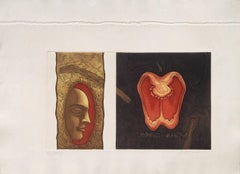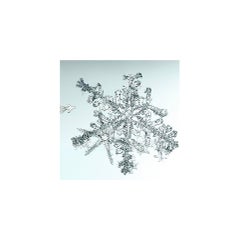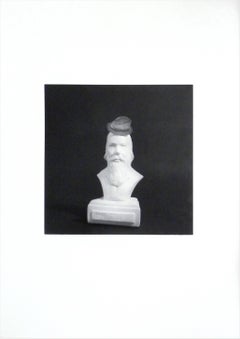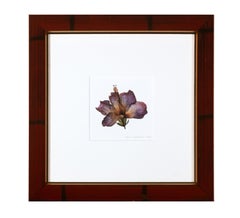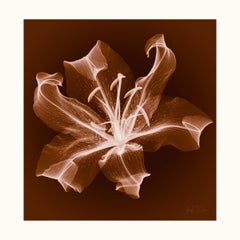Early 2000s Still-life Prints
to
17
34
24
40
23
5
Overall Width
to
Overall Height
to
77
10
6
5
3
2
2
1
1
1
11
9
6
5
5
213
230
2,222
1,790
21
19
39
27
94
203
316
463
502
209
184
72
45
8
28
18
17
15
11
10
10
9
9
7
7
6
5
5
5
4
4
4
4
3
25
23
23
21
20
35
18
98
20
Period: Early 2000s
Face & Apple, Etching on Paper, Brown, Red & Yellow by Indian Artist " In Stock"
By Atin Basak
Located in Kolkata, West Bengal
Atin Basak - Untitled - 11 x 15 inches (Plate Size)
Etching on paper
Inclusive of shipment in a roll form
Style : Atin Basak says that his recent body of work represents the belief...
Category
Contemporary Early 2000s Still-life Prints
Materials
Paper, Etching
Untitled (Snowflake)
Located in Calabasas, CA
Artist: Doug & Mike Starn
Title: Untitled (Snowflake)
Year: 2006
Medium: Pigment print on Crane Museo paper
Edition: 30; signed, dated and numbered in penci...
Category
Contemporary Early 2000s Still-life Prints
Materials
Pigment
Brahms / Sombrero de fieltro
Located in Mexico City, MX
Artist's statement: In the last years, parallel to photography and video, I have been making works on canvas, prints, drawings, collages, and small installations. Many of these piece...
Category
Contemporary Early 2000s Still-life Prints
Materials
Photogravure
Lulú
Located in Mexico City, MX
Artist's statement: In the last years, parallel to photography and video, I have been making works on canvas, prints, drawings, collages, and small installations. Many of these piece...
Category
Contemporary Early 2000s Still-life Prints
Materials
Photogravure
'Hybrid Hibiscus I' Archival inkjet print
Located in Milwaukee, WI
Image: 2 1/2"x2 3/4"
Paper: 4 1/2"x4 1/4"
Frame: 9 1/2"x9 1/2"
Archival inkjet print
Signed in pencil lower right.
David Barnett, an artist, collector, appraiser and gallerist ha...
Category
Early 2000s Still-life Prints
Materials
Archival Ink, Digital
Laynes Lily - Classic Lily Flower X-Ray Print: Inkjet Print on Paper
By Hugh Turvey
Located in London, GB
In 2009, Hugh was appointed the first Artist in Residence for The British Institute of Radiology, since its inauguration in 1924 and Royal Charter granted by Her Majesty the Queen in...
Category
Contemporary Early 2000s Still-life Prints
Materials
Paper, Inkjet
Kale Cavalo Nero - Chromaluxe Print / X-Ray Photography: Simple Monochrome
By Hugh Turvey
Located in London, GB
In 2009, Hugh was appointed the first Artist in Residence for The British Institute of Radiology, since its inauguration in 1924 and Royal Charter granted by Her Majesty the Queen in...
Category
Contemporary Early 2000s Still-life Prints
Materials
Metal
Untitled
Located in Barcelona, BARCELONA
Includes a Certificate of Authenticity
Category
Expressionist Early 2000s Still-life Prints
Materials
Engraving
Star, from American Signs Portfolio
Located in New York, NY
ROBERT COTTINGHAM
Star, from American Signs portfolio, 2009
screenprint in colors, on wove paper, with full margins,
40 1/8 x 39 1/8 in (101.9 x 99.4 cm)
signed, dated `2009' and numbered edition of 100 in pencil
--
Robert Cottingham
B. 1935, BROOKLYN, NEW YORK
Born in 1935 in Brooklyn, Robert Cottingham is known for his paintings and prints of urban American landscapes, particularly building facades, neon signs, movie marquees, and shop fronts. After serving in the U.S. Army from 1955 through 1958, he earned a BFA at Pratt Institute, Brooklyn, in 1963. Cottingham began his professional artistic career as an art director for the advertising firm Young and Rubicam in the early 1960s. Although he is typically associated with Photorealism, Cottingham never considered himself a Photorealist, but rather a realist painter working in a long tradition of American vernacular scenes. In this respect, his work often draws parallels to a number of American painters such as Stuart Davis, Charles Demuth, Edward Hopper, and Charles Sheeler.
Cottingham’s interest in the intersections of art and commerce derive from his career as an adman and the influence of Pop art. Many of his paintings convey an interest in typography and lettering, as well as an awareness of the psychological impact of certain isolated words and letters. In his facades, techniques from advertising, namely cropping and enlarging, often produce words of enigmatic or comical resonance such as “Art,” “Ha,” or “Oh.” Cottingham’s enlarged sense of scale is reminiscent of James Rosenquist’s work, while his interest in text suggests the influence of Robert Indiana and Jasper Johns. In general, Cottingham viewed his work as continuing the legacy of Pop artists such as Andy Warhol, who also had a background in advertising.
In 1964, Cottingham relocated to Los Angeles for work. There, inspired by the drastically different environment of the West Coast metropolis, he began to commit seriously to painting. Fascinated by Hollywood’s exaggerated glitz and the downtrodden atmosphere of the downtown, Cottingham saw in Los Angeles the relics of a bygone commercial heyday and desired to capture its kitschy and uncanny atmosphere, bathed in the near perpetual sunlight of Southern California.
In 1968, Cottingham ended his advertising career in order to devote all his time to painting. In the late 1960s, he started using photography in his practice, first as an initial reference point for his process. After selecting a photograph, he translates it into black-and-white drawings by projecting the image onto gridded paper...
Category
Photorealist Early 2000s Still-life Prints
Materials
Screen
American Signs portfolio
Located in New York, NY
ROBERT COTTINGHAM
American Signs portfolio, 2009
The complete set of twelve screenprints in colors, on wove paper, with full margins, 40 1/8 x 39 1/8 in (101.9 x 99.4 cm)
all signed, dated `2009' and numbered edition of 100 in pencil, published by Exhibit A Fine Art and Editions and American Images Atelier, New York, all in excellent condition, contained in original gray silk-covered box with artist and title embossed with gold foil.
Robert Cottingham
B. 1935, BROOKLYN, NEW YORK
Born in 1935 in Brooklyn, Robert Cottingham is known for his paintings and prints of urban American landscapes, particularly building facades, neon signs, movie marquees, and shop fronts. After serving in the U.S. Army from 1955 through 1958, he earned a BFA at Pratt Institute, Brooklyn, in 1963. Cottingham began his professional artistic career as an art director for the advertising firm Young and Rubicam in the early 1960s. Although he is typically associated with Photorealism, Cottingham never considered himself a Photorealist, but rather a realist painter working in a long tradition of American vernacular scenes. In this respect, his work often draws parallels to a number of American painters such as Stuart Davis, Charles Demuth, Edward Hopper, and Charles Sheeler.
Cottingham’s interest in the intersections of art and commerce derive from his career as an adman and the influence of Pop art. Many of his paintings convey an interest in typography and lettering, as well as an awareness of the psychological impact of certain isolated words and letters. In his facades, techniques from advertising, namely cropping and enlarging, often produce words of enigmatic or comical resonance such as “Art,” “Ha,” or “Oh.” Cottingham’s enlarged sense of scale is reminiscent of James Rosenquist’s work, while his interest in text suggests the influence of Robert Indiana and Jasper Johns. In general, Cottingham viewed his work as continuing the legacy of Pop artists such as Andy Warhol, who also had a background in advertising.
In 1964, Cottingham relocated to Los Angeles for work. There, inspired by the drastically different environment of the West Coast metropolis, he began to commit seriously to painting. Fascinated by Hollywood’s exaggerated glitz and the downtrodden atmosphere of the downtown, Cottingham saw in Los Angeles the relics of a bygone commercial heyday and desired to capture its kitschy and uncanny atmosphere, bathed in the near perpetual sunlight of Southern California.
In 1968, Cottingham ended his advertising career in order to devote all his time to painting. In the late 1960s, he started using photography in his practice, first as an initial reference point for his process. After selecting a photograph, he translates it into black-and-white drawings by projecting the image onto gridded paper...
Category
American Realist Early 2000s Still-life Prints
Materials
Screen
